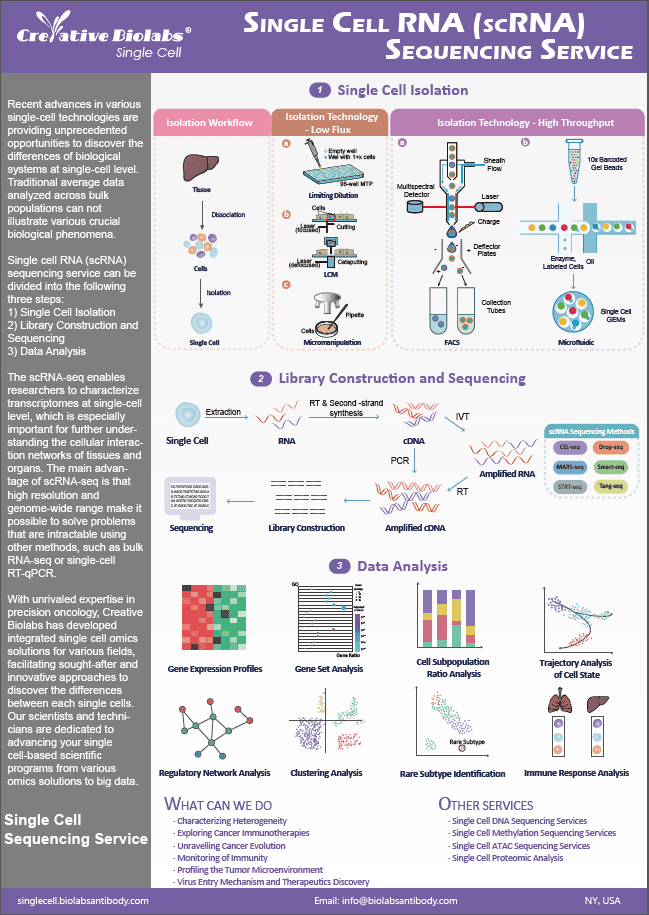RNA Microarray Services
RNA microarray is a microchip used to measure RNA levels. RNA microarrays have been widely used to identify the regulated genes, pathways, and gene networks in a variety of cells and tissues when two or more related biological conditions are compared.
RNA Microarray Introduction
Printing cDNA microarrays on glass slides was the first microarray technique developed and is still commonly used. cDNAs are amplified from individual clones in a library. Each cDNA fragment represents an individual gene of interest and is immobilized on a glass slide that has been coated with DNA-binding chemicals such as amino silane or poly-Lysine. These slide arrays can be printed as whole genome microarrays or with a focused selection of genes of interest.
RNA Microarray Services
Despite the many benefits of RNA-seq, many researchers still use RNA microarrays, particularly for studies with relatively large sample sizes. Because it is more reliable and saves time, the RNA microarray is also very popular in clinical research.
- Gene Expression Array
- miRNA Array
- lncRNA Array
- circRNA Array
A gene expression array is a compact, massively parallel, and semi-automated method for monitoring gene product concentrations (or mRNA or transcripts) and can be used to diagnose the presence of an illness.
miRNA (micro-RNA) arrays can detect mature miRNAs and differentiate between highly similar miRNA molecules. It is widely used for detecting and comparing the expression status of microRNAs in different samples, analyzing the target genes they regulate, and investigating their regulation mechanisms or biological functions.
LncRNA array is a method for profiling lncRNAs in addition to the complete collection of protein-coding mRNA. It is the most effective method for profiling lncRNAs, surpassing many of the limitations of RNA-seq for lncRNAs that are frequently of low abundance.
circRNA array is a method for profiling and analyzing circular RNAs.
Gene Expression Array Service
Creative Biolabs provides high-resolution array scanning and automation services to substantially improve gene expression efficiency. We have experience processing manufacturer-supplied microarrays in standard slide format. To provide genome-wide expression profiles of humans, model organisms, plants, and animals, these microarrays are constructed.
Learn MoremiRNA Array Service
The miRNA microarray technique is widely used since it is high throughput, inexpensive, and most of the experiments and analysis steps can be done in molecular biology laboratories at universities, medical schools, and affiliated institutions. Creative Biolabs, a leading biotechnology company, offers unique miRNA microarray services.
Learn MoreLncRNA Array Service
Unlike protein-coding genes, publicly available lncRNAs are frequently poorly annotated, restricted in scope, and dispersed in the collection. Creative Biolabs maintains a high-quality, proprietary lncRNA transcriptome database comprising lncRNAs from all major public databases and repositories, knowledge-based mining of scientific papers, and our lncRNA discovery workflows.
Our lncRNA arrays are intended to profile lncRNAs in addition to all protein-coding mRNAs. They are the most efficient method for profiling lncRNAs, overcoming many of the limitations of RNA-seq for frequently rare lncRNAs.
Learn MorecircRNA Array Service
By systematically evaluating the expression of circRNAs, Creative Biolabs provides a platform for profiling, analyzing, and exploring this new and intriguing world of non-coding RNAs. From sample to publishable data, we offer the circRNA array specialized service.
Learn MoreCreative Biolabs offers diverse RNA microarray services, including gene expression, miRNA, lncRNA, and circRNA microarrays. For more information, please contact us.
Features & Benefits
-
High-Throughput Screening
RNA microarrays can process thousands of genes simultaneously, allowing for rapid comparison across multiple samples. This makes it a powerful tool for large-scale gene expression studies, crucial in identifying disease biomarkers and drug targets. -
Comprehensive Coverage
RNA microarrays provide extensive coverage of the genome, including known gene sequences and potential regulatory elements. This comprehensive data helps researchers better understand complex gene networks involved in disease processes. -
Speed of Analysis
The technology allows for quick turnaround times from sample preparation to data analysis, which is essential in fast-paced research environments where timely results can accelerate drug development cycles. -
Quantitative Analysis
RNA microarrays provide quantitative measurements of gene expression, facilitating the comparison of expression levels across different samples under various conditions. This is crucial for accurate dose-response studies in pharmacological research. -
Standardized Workflows
RNA microarray services often come with standardized protocols and workflows, ensuring consistent and reproducible results across different experiments and studies. This standardization is critical for regulatory compliance in drug development.
Q&As
Q: What types of RNA can be analyzed using microarrays?
A: Microarrays can analyze different types of RNA, including mRNA, miRNA, and non-coding RNA. This allows researchers to explore various aspects of the genome, from protein-coding genes to regulatory RNA molecules that play critical roles in gene expression.
Q: What sample requirements are needed for RNA microarray analysis?
A: The quality and quantity of RNA are crucial for microarray analysis. Typically, a minimum of 50 ng of total RNA is required, with an OD260/280 ratio greater than 1.8, indicating good purity. The RNA should also be intact, which is often verified using bioanalyzer assessments.
Q: How does microarray technology compare to next-generation sequencing (NGS) for RNA analysis?
A: Microarray technology is often faster and less expensive than NGS but offers lower resolution and cannot detect novel RNA sequences or splice variants not represented on the array. In contrast, NGS provides a more comprehensive analysis of the RNA landscape, including the ability to identify novel transcripts and more detailed quantification of expression levels.
Q: How is data from RNA Microarray analyzed?
A: Data analysis involves normalizing the raw signals, identifying differentially expressed genes, and performing statistical analyses to determine significance. Advanced bioinformatics tools are used to interpret the data, providing insights into biological pathways and gene networks.
Q: Can RNA Microarray be combined with other techniques?
A: Yes, RNA Microarray can be combined with other techniques such as qPCR, RNA-Seq, and proteomics. This multi-omics approach provides a more comprehensive understanding of gene expression regulation and functional outcomes in biological systems.
Resources
Search...


